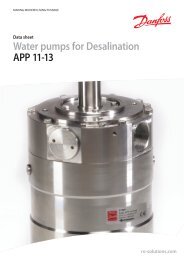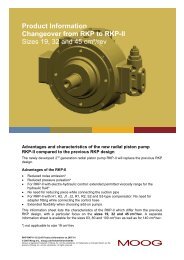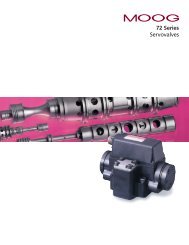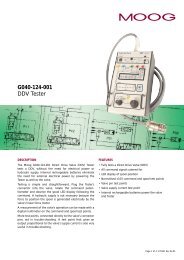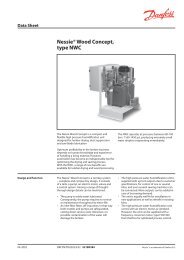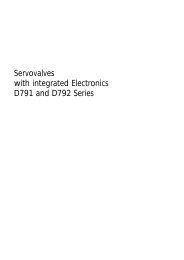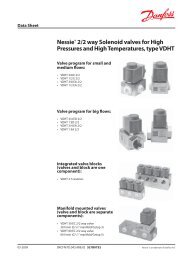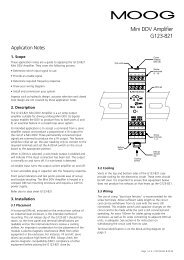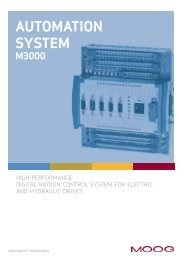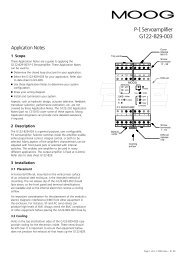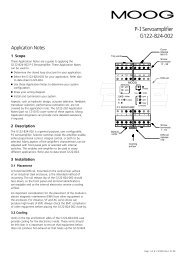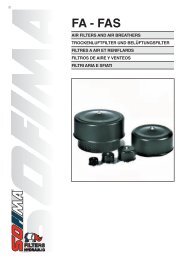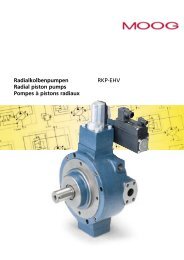G123-818 Series Signal Conditioner - Moog Inc
G123-818 Series Signal Conditioner - Moog Inc
G123-818 Series Signal Conditioner - Moog Inc
- No tags were found...
Create successful ePaper yourself
Turn your PDF publications into a flip-book with our unique Google optimized e-Paper software.
<strong>Signal</strong> <strong>Conditioner</strong><strong>G123</strong>-<strong>818</strong>Application Notes1 ScopeThese application notes are a guide to applying the <strong>G123</strong>-<strong>818</strong><strong>Signal</strong> <strong>Conditioner</strong>. They tell you how to install, connect andadjust the <strong>Signal</strong> <strong>Conditioner</strong>. They do not tell you how todesign the system in which it is used.Top ventsCover release tabScrewterminals9 - 162 DescriptionThe <strong>G123</strong>-<strong>818</strong> <strong>Signal</strong> <strong>Conditioner</strong> is typically used with a loadcell or other low output transducer and provides a conditioned±10 V output and a 4-20mA current output. The 4-20mAoutput can be selected as unipolar or bipolar. A typicalapplication is where a load cell is the transducer used inconjunction with <strong>Moog</strong> servo actuators.A wide adjustment range is provided for excitation, span andzero to allow the majority of commercial load cells to beaccommodated.Calibration using a precision shunt resistance is supported. Twoshunt sources are provided. Either the on board plug-inresistors or an external user provided shunt can be selected byDip switch.The <strong>G123</strong>-<strong>818</strong> <strong>Signal</strong> <strong>Conditioner</strong> can also be used as a standaloneinstrument for static or dynamic force measurement,outputting a scaled ± DC voltage or current.Refer also to data sheet <strong>G123</strong>-<strong>818</strong>.3 Installation3.1 PlacementA horizontal DIN rail, mounted on the vertical rear surface ofan industrial steel enclosure, is the intended method ofmounting. The rail release clip of the <strong>G123</strong>-<strong>818</strong> should facedown, so the front panel and terminal identifications arereadable and so the internal electronics receive a cooling airflow. An important consideration for the placement of themodule is electro magnetic interference (EMI) from otherequipment in the enclosure. Always check the EMCcompliance of other equipment before placing the <strong>G123</strong>-<strong>818</strong>close by.3.2 CoolingVents in the top and bottom sides of the <strong>G123</strong>-<strong>818</strong> caseprovide cooling for the electronics inside. These vents shouldbe left clear. It is important to ensure that equipment belowdoes not produce hot exhaust air that heats up the <strong>G123</strong>-<strong>818</strong>.Cover release tabBottomventsCoolingairflowDIN railreleaseclipDIN railScrewterminals1 - 8cables going outside the enclosure, as well as wires connectingto adjacent DIN rail units, is adequate.For the load cell use quality 2 or 3 twisted pair screened cable.One pair is used for the excitation, one pair for the signal andone pair for the excitation sense. For load cell cable lengthsgreater than 5 m it is recommended to use 6 wire senseconnection.Consult manufacturers instruction for connections as wirecolours vary.EnclosureGrounded EMIcable glandWires100mm Loop3.3 WiringThe use of crimp “boot lace ferrules” is recommended for thescrew terminals. Allow sufficient cable length so the circuitcard can be withdrawn from its case with the wires stillconnected. This enables the internal switch settings for spanand excitation and plug-in filter resistors to be set while thecard is still connected and operating. An extra 100 mm, forCableRadial screenterminationPreferred WiringPage 1 of 4: C31961 Rev A 01.03
EnclosureCable glandCable3.4 EMCWire solderedto screenorDrain wire.(Heat shrink tocover the screen)Alternative WiringCable100mm LoopThe <strong>G123</strong>-<strong>818</strong> emits radiation well below the level called for inits CE mark test. Therefore no special precautions are requiredfor the suppression of emissions. However, immunity fromexternal interfering radiation is dependent on careful wiringtechniques. The accepted method is to use screened cables forall connections and to radially terminate the cable screens, inan appropriate grounded cable gland, at the point of entry intothe industrial steel enclosure. If this is not possible, chassisground screw terminals are provided on the <strong>G123</strong>-<strong>818</strong>.Exposed wires should be kept to a minimum length. Connectthe screens at both ends of the cable to chassis ground. Theuse of double screened cable for the load cell is suggested innoisy environments.4 Power supply24 V nominal, 22 to 28 V.100mA @ 24 V with 350 Ω load cell @ 10 V excitation and20mA output load current.If an unregulated supply is used the bottom of the ripplewaveform is not to fall below 22 V.5 Set-up adjustmentsLEDTest pointPOTLEDPOTTest pointSwitchS1S2Ra1S4J3RdRcRbRcal1Rcal2(Refer to tables in Section 8 for DIP switch settings and resistorplug-ins)5.1 ConnectionWhere the load cell is remote from the <strong>G123</strong>-<strong>818</strong> and wherevariation in ambient temperature occurs during measurement,6 wire connection should be used. This ensures constantexcition at the load cell.5.2 ExcitationIt is beyond the scope of these application notes torecommend excitation levels. Consult the load cellmanufacturers data to determine the excitation voltage.• Switches S4.4 and S4.5 select 5 V or 10 V excitation.8• Switch S4.2 allows excitation to be disconnected so noisecan be measured with a load cell connected. To preventexcitation flowing through the sense wire, 4 wire connectionshould be selected by setting S4.3 to off.5.3 Filter• Filter frequency should be configured appropriately for theload cell and application, refer to table in section 8.Filter frequencies in the range 5 to 1000Hz can be obtained byselecting appropriate plug-in resistors.The default corner frequency for the low pass filter is 1000Hz.The resistors used should be 1% tolerance, 50ppm/ºC tempco,metal film, “ 1 /4 W size”.Suggested types are:Roderstein MK2 0207Beyschlag MBB 02075.4 Input sensitivity• Select the sensitivity range that suits the load cell you areusing.Example:A 350 Ω load cell with a 2.0 mV/V sensitivity will have a fullscale output of 20mV at 10 V excitation. Span range 2 (12 to26mV) will allow output to be scaled up to ±10 V.• With no load applied, adjust front panel Zero trimpot to give0 V out at the front panel output test point.• With a known load applied or a simulated load using shuntcalibration, adjust the Span trimpot to give the desiredscaled output. Shunt calibration procedure is described insection 5.6.The output should not be greater than ±10 V.Example:A load cell with a 1000kg full scale capacity can be scaled bythe application of 100kg and adjusting the output to read1.000V. The scaled output is then 10mV/kg.5.5 OutputBoth ±10 V and 4-20mA outputs are provided and can beused simultaneously.The 4-20mA current output can be configured for unipolarmode or bipolar mode by slide switches S1 and S2.• Unipolar mode: S1, S2 = +10 V.• Bipolar mode: S1, S2 = ±10 V.In bipolar mode 0 V at the voltage output produces 12mA onthe current output.5.6 Shunt calibrationWhere direct calibration using a known load is not possible,shunt calibration provides an output for a simulated strain.A calibration resistance of 174,650 Ω simulates 1000 µstrainwith a 350 Ω load cell and gauge factor of 2.0.For other load cell resistances the strain values can bedetermined from the following relationships.Rcell = Load cell resistanceRcal = Calibration resistanceε = µStrainGF = Gauge FactorThe relationship between the resistance change ∆R and thesimulated strain is:∆R = GF x εRcellPage 2 of 4: C31961 Rev A 01.03
The resistance change by applying the shunt across one arm ofthe load cell bridge is:∆R = RcellRcell (Rcal + Rcell)For Rcal = 174,650 Ω with a 350 Ω load cell at 10 V excitation∆R/R = 0.002. The voltage at the load cell output with theshunt applied is 5mV.Example:The full scale output for a 1000kg load cell with 2.0mV/Vsensitivity at 10 V excitation is 20mV. The calibration shuntapplication produces a load equivalent of 20/5mV = 250kg.The output can be adjusted to read 2.500V. The scaled outputis then 10mV/kg.The Cal switch can apply the shunt to produce both + and –simulated strains.• The internal precision calibration resistance can be disabledand an external calibration resistance connected betweenterminals 3 and 4.Two on board calibration plug-ins are supported. Rcal 1 andRcal 2 are connected in parallel to allow desired value to beobtained from common values.The calibration resistance should be a precision type 0.1%tolerance, 15ppm/ºC tempco, metal film, “ 1 /4 W size”.A suggested type is: Welwyn RC55YB6 Test points and indicators• The output LED shows the polarity of the output signal.The LED is off for zero output.• The output and 0 V test points allow the actual filteredoutput signal to be measured while adjusting zero and span.7 Withdrawing the circuit card fromits caseThe circuit card needs to be withdrawn from its case to selectgain range, excitation voltage and filter frequency.To do this, push one tab in with a pen or screwdriver whilegently pulling on the top cover on that side. The cover willrelease approximately one mm. Repeat on the other side andwithdraw the cover and circuit card until the required circuitpoints are exposed. The rigidity of the connecting wires willhold the circuit card in position while the settings are made.8 Block Wiring Diagram+Sense13ExcitationS4:55V/10VTP0V+15VPower Supply1+24V+Excite-Excite-Sense91014S4:3S4:2S4:6-+S4:45V/10VPrecisionReference-15VLED Vo+ RED - GREEN25see note 10VLoad Cell orBridge Transducer+Input-Inputsee note 1Externalcalibrationresistor1211163Rcal 14InstrumentAmp+ -CAL S3S4.1Rcal 2S4:7S4:8+-+ref-refzero2nd order1000Hz LPFspan+ 10V/ 10VSelectS13rd orderselectable LPFS2Current OutputTPVo7610KVoltage Output84-20mA+ 10V0VFour filter plug inresistors Ra,b,c,dNote: 1. Connect cable screen to enclosure cable glandor chassis ground terminal on <strong>G123</strong>-<strong>818</strong>.4-20mA mode S1 S2Unipolar* +10 +10Bipolar ±10 ±10Input sensitivity forfull scale out. (mV) S4.8 S4.7 S4.61: 24 – 52 on off off2: 12 – 26 off on off3: 6 – 13* off off onExcitationvoltage (V) S4.4 S4.55.0* on on10.0 off offConection mode S4.34 wire* on6 wire offExcitation enable S4.2Excite on*onExcite offoffCalibration select S4.1Internal shuntonExternal shunt*offFilter plug-in resistancesFrequency (Hz) 5 10 50 100 500 1000*Ra,b,c (kΩ) 910 470 91 47 9.1 4.7Rd (kΩ) 300 150 30 15 3 1.5* = Factory defaults. Page 3 of 4: C31961 Rev A 01.03
9 SpecificationsFunctionalTransducer support:4 wire or 6 wire lead compensation,120 Ω minimum.Transducer excitation: selectable +5 or +10 V, 40mA max.Output:Internal switches:Connection:Full scale span range:Calibration select:Excitation:±10 V @ 10mA.4-20mA unipolar, or4-20mA bipolar, 12mA = no load.4 wire or 6 wire transducer.1: 24 to 52mV2: 12 to 26mV3: 6 to 13mVInternal or external user shunt.5 or 10 V and on/off selection.Switch functions also available on test header for remoteconfiguration.Filter:Front panel adjustments:Span:Zero:Shunt calibration:Front panel LED’s:Front panel testpoints:Low pass, 3rd order, selectable byfour plug-in resistors.Frequency range 5 to 1000Hz.15 turn trimpot.±2.5 % full scale by 15 turntrimpot.Centre off, ± shunt connection,toggle switch.Vs, internal supply = greenVo, output polarity, positive = red,negative = green, zero = off.Vout and 0 V, 2mm test plug.Environmental and physicalSupply:Mounting:+24 V nominal, +22 to +28 V range.100mA @ 24 V supply, with 350 Ωload cell, 10 V excitation and 20mAoutput load current.DIN rail.Class of protection: IP 20.Operating temperaturerange:Dimensions:0 - 40°C.Weight: 140 g.Approvals:PerformanceInput impedance:100W x 108H x 22.5D.CE Mark: EN50081.1 emission.EN61000-6-2 immunity.C tick: AS4251.1 emission.>10 MΩCMRR: >100 dB @ gain = 200Noise:Temp stability:Drift:Linearity:Input protection: ±40 V.Output protection:



